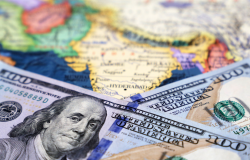
A blog of the Brazil Institute
Brazil Trade with United States Sees Lowest Result in 11 Years
The most notable change in Brazilian foreign policy since the election of President Jair Bolsonaro in 2018 has been the country's full alignment with the United States. However, this shift in allegiances has yet to result in concrete commercial gains for Brazil—in fact, bilateral trade with the United States has just seen its worst result in 11 years. Between January and September of this year, accumulated trade between the two countries totaled $33.4 billion, a 25 percent drop from the same period in 2019.
Regardless, the United States remains Brazil's second-largest trading partner, accounting for 9.7 percent of Brazilian exports and 12.3 percent of revenue. Only China retains a larger slice, buying over one-third of Brazil's exports.
According to data from the American Chamber of Commerce in Brazil (AmCham Brasil), 2020 is likely to conclude with a Brazil-U.S. trade deficit between $2.4 and 2.8 billion—the worst result in five or six years. The findings are presented in AmCham Brasil's latest Brazil-U.S. Trade Monitor, published earlier this month.
Sluggish Trade: Pandemic to Blame?
The AmCham Brasil report identifies three leading factors to explain the sharp downturn in bilateral trade. “The combination of the severe effects of the economic crisis caused by the [COVID-19] pandemic, the fall in global oil prices, and trade restrictions in specific sectors—such as the steel industry—account for a large part of the contraction in bilateral trade,” explained AmCham Brasil's Executive Vice President Abrão Neto.
Mr. Neto went on to say that the delayed effect of the pandemic on imports was due to the customs clearance of orders made and shipped before the crisis, which continued to be processed in the early stages of the pandemic. Furthermore, a large part of Brazil’s trade with the United States is made up of intra-company exchanges, which may have taken some time to reflect the drop in demand.
“It was a severe blow for bilateral commerce, but our assessment is that the worst is behind us,” said Mr. Neto. AmCham Brasil is confident in the recovery of international goods and services trade, and of the demand this will bring to Brazilian and U.S. exporters.
Amid the unforeseen COVID-19 crisis, the trade war between the United States and China is set to regain importance. “This will continue for some time and the entire world is factoring it into the equation as a variable,” said Mr. Neto. However, he stressed that tensions between the two powerful countries are unlikely to be particularly crucial in Brazil-U.S. relations, but will certainly have an effect on global trade as a whole.
In September of last year, the International Monetary Fund (IMF) predicted growth of just 0.8 percent for the global economy in 2020, as a result of the China-U.S. trade war. This, of course, was before the COVID-19 pandemic came to decimate all forecasts for this year.
Difference Between the United States and China
Brazil's export portfolio to the United States—with 87.2 percent comprised of products with higher added value—to an extent explains the fall in trade seen in 2020. For instance, the trend is drastically different in Brazil-China trade, which saw an uptick due to the dominance of agricultural commodities.
The one commodity that did have an influence on Brazil's trade balance with the United States was oil, prices of which have yet to return to pre-pandemic levels after collapsing in March. In total, oil and fuel make up 8.9 percent of all Brazilian exports to the United States.
Like the content? Subscribe to the Brazilian Report using the discount code BI-TBR20 to get 20 percent off any annual plan.

About the Author

The Brazilian Report
Read More
Brazil Institute
The Brazil Institute—the only country-specific policy institution focused on Brazil in Washington—aims to deepen understanding of Brazil’s complex landscape and strengthen relations between Brazilian and U.S. institutions across all sectors. Our mission is to provide thoughtful leadership and innovative ideas to help democracies evolve and enhance their capacity to deliver results. We achieve this by producing independent research and programs that bridge the gap between scholarship and policy, while serving as a hub for policymakers, scholars, and private sector leaders. Read more













